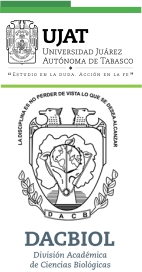TORTUGAS DULCEACUÍCOLAS Y EL MANATÍ ANTE LOS ESCENARIOS DEL CAMBIO CLIMÁTICO EN EL SUR DEL GOLFO DE MÉXICO
DOI:
https://doi.org/10.19136/kuxulkab.a18n34.243Abstract
Se discuten los efectos posibles de los escenarios del cambio climático sobre las tortugas dulceacuícolas y manatíes, dos componentes carismáticos e importantes de los humedales del sur del Golfo de México. Los componentes más importantes de los escenarios son el aumento del nivel del mar, la temperatura y la precipitación en las próximas décadas. Estos factores impactarán sobre mecanismos reproductivos, fisiológicos y sobre la salud de las poblaciones. En el caso de las tortugas, el aumento de temperatura influirá sobre las especies con determinación de sexo por temperatura, en la fenología y la estivación, mientras que en el manatí el principal impacto será al constreñir su hábitat y los riesgos de escasez de alimento en períodos prolongados de sequía. En ambas especies la interacción con la gente será más intensa y sinérgica con los otros cambios que posiblemente han enfrentado y librado en el pasado.Downloads
References
Aguirre, G., E. Cázeres & B. Sánchez. 2002. Conservación y aprovechamiento del chopontil (Claudius angustatus). Instituto de Ecología. Xalapa, Ver. 29 p.
Álvarez del Toro, M. 1982. Los reptiles de Chiapas. Colección libros de Chiapas. Tuxtla Gutiérrez, Chiapas, México. 215 p.
Crews, D. 1996. Temperature-dependent sex determination: the interplay of steroid hormones and temperature. Zool. Sci., 13: 1-13
Ewert, M.A. 1985. Embryology of turtle. In: Biology of the Reptilia 14. A wiley-intercience publication, Jonh Wiley and Sons. N.Y. Pp. 76-267.
Ewert, M. A., Jackson, D. R. & Nelson, C. E. 1994. Patterns of temperatura-dependent sex determination in turtles. J. exp. Zool., 270: 3-15
Ewert, M., J.W. Lang and C.E. Nelson. 2005. Geographic variation in the pattern of temperature-dependent sex determination in the American snapping turtle (Chelydra serpentina). J. Zool. Lond., 265: 81-95
Frederick, K. 1997. Water resource y climatic changes. Climate Issues Brief No. 3 Resources for the Future. 14 p.
Gallivan, G.J. & R.C. Best. 1986. The influence of feeding and fasting on the metabolic rate and ventilation of the amazonian manatee (Trichechus inunguis). Physiological Zoology, 59(5): 552-557
Glen, F. and N . Mrosovsky. 2004. Antigua revisited: the impact of climate change on and nest temperatures at a hawksbill turtle (Eretmochelys imbricata) nesting beach. Global Change Biology, 10: 2036-2045
Hawkes, L.A. Broderick, A.C., Godfrey, M.H. and Godley, B.J. 2007. Investigating the potential impacts of climate change on a marine turtle population. Global Change Biology.
IPCC. 2001. Tercer Informe de Evaluación del Cambio climático 2001. Intergovernmental Panel on Climate Change (IPCC). Climate Change 690 2001: The Scientific Basis, (eds Houghton JT, Ding Y, Griggs DJ, Noguer M, 691 van der Linden PJ, Xiaosu D) Contribution of working group I to the third 692.
Janzen, F.J. & P.C. Phillips. 2006. Exploring the evolution of environmental sex determination, especially in reptiles. European Society for Evolutionary Biology, 19: 1775-1784
Janzen, F.J. 1994. Climatic change and temperature- dependent sex determination. Proc. Natl. Acad. Sci., 91: 7487-7490
Jones, K.B. 1986. Amphibians and reptiles. In: Cooperrider, A.Y., R.J. Boyd and H.K. Stuard (eds). Inventory and monitoring of wildlife habitat. Bureau of land management. Fish and wildlife Service. EUA. 857 p.
Kusler, J., Brinson, M., Niering, W., Patterson, J., Burkett, V. & Willard, D. 1999. Wetlands and climate change: scientific knowledge and management options. White Paper Institute for Wetland Science and Public Policy, Association of State Wetland Managers / Wetlands International. 27 p.
Kuchling. 1998. Population structure, reproductive potential and increasing exploitation of freshwater turtle Erymnochelys madagascariensis. Biol. Conserv., 43: 107-113
Kutchlin. G. and S.D. Bradsaw. 1993. Ovarian Cycle and egg production of the west swamp tortoise Pseudemydura umbrina. (testudines: Chelididae) in the wild and captivity. J. Zool., 229: 405-409
Levins, R. 1969. Some demographics and genetic consequence of environmental heterogeneity for biological control of environmental heterogeneity for biological control. Bulletin Entomological Society America, 15: 237-240
Limpus, C. & J. Nicholson. 1993. The southern oscillation regules the annual number of green turtle (Chelonya mydas) breeding around northern Australia. Aust. Wildlife Res., 15: 157-161
Marchand, M.N and J. Litvaitis. 2004. Effects of habitat feature and landscape composition on the population structure of common aquatic turtle in a region undergoing rapid development. Conservation Biology, 18(3): 758-767
Mc Carty, J.P. 2001. Ecological consequences of recent climatic change. Conservation Biology, 15(2): 320-331
Moll, D & E. Moll. 2004. The ecology, explotation and conservation of river turtles. Oxford University Press. 393 p.
Moll, D & E. Moll. 1990. The slider turtle in the Neotropics: adaptations of a temperates species to a tropical enviroment. IN: Life history and ecology of slider turtle. J.W. Gibbons (ed). Smithsonian Intitute Press. Washinton, D.C.
Moll, D. & Lagler. 1971. The life history of a neotropical turtle Pseudemys scripta (Schoepff), in Panama. The Angeles Co. Museum Sci. Bull., 11: 1-102
Morales-Vela B. & L.D. Olivera-Gómez. 1996. Manatee rescue in Chiapas. P. 11, En: Domning, D.P. (ed.). Sirenews, Newsletter of the IUCN/SSC Sirenia Specialist Group, No. 25
Naiman RJ, Bilby RE, (eds). 1998. River Ecology and Management: Lessons From the Pacific Coastal Ecoregion. New York: Springer-Verlag. 705 p.
Nourisson, C., B. Morales-Vela, J. Padilla-Saldivar, K.P. Tucker, A. Clark, L.D. Olivera-Gómez, R.K. Bonde & P. McGuire. (In press). Evidence of two genetic clusters of manatees with low genetic diversity in Mexico and implications for their conservation. Genetica.
Olivera-Gómez, L.D. 2007. Manatees at freshwater systems in southeastern Mexico. Pp. 11-13, In: C.R. Taylor and J.P. Powell (Eds). Sirenews Newsletter of the IUCN/SSC Sirenia Specialist Group 48.
Olivera Gómez, L.D. 2008. Los manatíes y el cambio climático. Diálogos, 28: 11-16
Ortiz Pérez, M.A. & A. P. Méndez Linares. 2006. Repercusiones por ascenso del nivel del mar en el litoral del golfo de México. En: México: una visión hacia el siglo XXI el cambio climático en México.
Pascarella, J.B. 1998. Hurricane disturbance, plant-animal interactions, and the reproductive success of a tropical shrub. BlOTROPlCA, 30(3): 416-424
Polisar, J. 1995. River turtle reproductive demography and exploitation pattern in Belice: implication for management. Vida Silvestre Neotropical, 4: 10-19
Richardson, D.M., P.Holmes, K. Esler, S. Galastowitsch, J. Armstrong, S. Kirkman, P. Pysek and R. Hobbs. 2007. Riparian vegetation: degradation, alien plant invasion, and restoration prospects. Biodiversity Research 13: 126-139
SEMARNAR & PNUMA. 2006. El cambio climático en América Latina y el Caribe. México, D.F. 136 p.
Yáñez-Arancibia, A., R. R. Twilley &A. L. Lara-Domínguez. 1998. Los ecosistemas de manglar frente al cambio climático global. Madera y Bosques, 4(2): 3-193
Vogt, R. 1990. Reproductive parameters of Trachemys scripta venusta in southern Mexico. In: Life history and ecology of Slider turtle. J.W. Gibbons (eds). Smithsonian institution Press. Washinton, D.C.
Vogt, R. and O. Flores-Villela. 1992. Effects of incubation temperature on sex determination in a community of neotropical freshwater turtles in southern Mexico. Herpetologica, 48(3): 265-270
Warren, R.S. y Niering, N.A. 1993. Vegetation change on a Northeast Tidal Marsh: Interaction of Sea level Rise and marsh accretion. Ecology, 74: 96-103
Willete, D.A.S., J.K. Tuker y F.J. Janzen. 2005. Linking climate and physiology at the population level for a key life-history stage of turtles. Canadian Journal of Zoology, 83: 845–850
Zenteno R., C.E. 1994. Estudio reproductivo de tres especies de tortugas de agua dulce en el Estado de Tabasco. Tesis de Licenciatura. Universidad Juárez Autónoma de Tabasco.
Published
Issue
Section
License
Los autores que publiquen en Kuxulkab' aceptan las siguientes condiciones como política de acceso abierto:
1. Que conservan los derechos de autor y ceden a la revista el derecho de la primera publicación, con el trabajo registrado con la licencia de atribucion de "Creative Commons", que permite a terceros utilizar lo publicado siempre que mencionen la autoría del trabajo y a la primera publicación en esta revista.
2. El autor puede realizar otros acuerdos contractuales independientes o adicionales para la distribución no exclusiva de la versión del artículo publicado en esta revista, como por ejemplo incluirlo en un repositorio institucional o publicarlo en un libro, siempre que se indique claramente que el trabajo se publicó por primera vez en esta revista.












